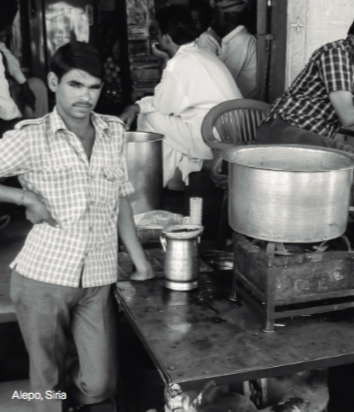Aleppo’s Souq al-Madina
by Michael Snyder
A question I get a lot is: ‘What’s the best meal you’ve ever eaten?’ It’s not a question I can answer honestly, since that would require remembering every meal I’ve ever eaten and, once I’ve done that, comparing my 21st birthday dinner at French Laundry to my first taste of tacos de tripa in Mexico City (tacos win, hands down). But I have an answer nevertheless, one that I’ve repeated enough times that I’m even pretty sure it’s true. The answer I give is that I ate the best meal of my life when I was 20 years old, on foot, cloaked smoke in what is, by some measures, the world’s oldest marketplace: the great souq of Aleppo in Syria.
It’s hard, as an outsider, to talk about the souqs without using the vocabulary of an orientalist, because, at least as I remember them, they really did smell of frankincense and the air really did seem to be made of golden dust and the stone archways overhead, punctured by Arabian light, really did seem immortal, though, of course, they weren’t.
The food was elementally simple: a skewer of lamb’s liver hot off a charcoal grill folded into a fresh round of pita with charred tomatoes and onions, a frond of parsley, and a flurry of smoky red Aleppo pepper. It was just a wrap, but I nearly swooned after my first bite and while that probably had at least something to do with the 100-degree heat, I’m also pretty sure it was the food. When I’d licked the last dusting of flour off my fingers, I stepped out of the souqs and immediately saw a young kid standing behind a pair of carts, one piled high with dark purple mulberries, the other holding a giant block of ice, melting slowly in the desert heat. I asked for one of whatever he was making. He scraped ice off the block and into a plastic cup, poured a thick stream of fresh mulberry nectar over it and, before giving it to me, sprinkled my hands with rosewater, which may well be the most luxurious thing I’ve ever experienced.
In the US, where I grew up, we have supermarkets and farmer’s markets, urban markets that have become tourist markets and, increasingly, fancy food halls that call themselves markets, but very few actual markets. Which, I guess, is why I’ve been so singularly enchanted by markets for so many years. Since 2010, I’ve lived in Santiago de Chile, where the food is boring but the markets extraordinary; in Mumbai, a city where the distinction between markets and streets is vague, at best; and now in Mexico City, where, despite some truly world class restaurants, the very best food is still to be found in markets.
Wherever I’ve lived and wherever I’ve traveled, most of my favorite meals have been eaten in markets. There have been the perfect three-course lunches eaten at narrow counters in the Mercados de San Juan and Merced; the drunken early morning seafood feasts in Santiago’s Mercado Central; the towering plates of masala khichiya – a charred tapioca crisp topped with chutneys and vegetables and crispy shards of fried chickpea batter – eaten in the crowded lanes behind Mumbai’s fabric market; razor clams and wine in the Boquería; and endless cups of tea flavored with mint or sage, milk and cloves, served as an obligatory part of every business transaction in Cairo, Marrakesh, Jerusalem, and Delhi.
The essence of every market is perishability, a commerce built around the need to sell whatever’s there before it’s gone. There are no freezers or misters to keep food glistening and bright. The earlier you go, the better the choice. Each day in a market is a lifetime. It’s no wonder the US can’t fathom markets. There is perhaps no culture on earth so singularly obsessed with immortality. We put our old people away to die; we shop for produce that looks like it’s cast in wax in grocery stores lit like morgues; we go on cleanses and we jog and we take advice from celebrities whose lives (and skin) we’ll never have. To love a market you have to have at least a little love for death.
When I went to Aleppo it was 2008, and death hadn’t yet descended on the city as it would in a few years’ time. Syria then was still swaddled (or smothered) in autocractic order, which looks a lot like peace, but isn’t. The meal I ate that day remains so powerful in my memory at least in part because it’s a meal that I’ll never have again because the city that gave it to me no longer exists. It was perfect not just because it was pleasurable but because it is also, in retrospect, unbearably sad.
It’s such an infinitesimal loss compared to what so many others have lost in the intervening years, but it’s a loss nonetheless. I look at the devastation of Aleppo, one of the world’s great cities, through the manageable loss of that memory, like looking at an eclipse through milar, or at the inevitability of death through a pile of rotting apples or a block of melting ice.




